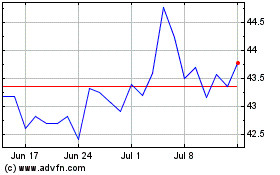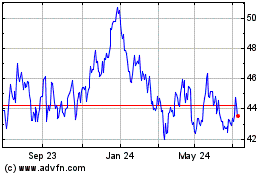Metal prices' rebound ends rough stretch marked by deep losses
and rush to cut debt
By Scott Patterson and Rhiannon Hoyle
The world's biggest miners are profit machines again, cashing in
on soaring commodity prices and rewarding investors who stuck with
them through a brutal downturn.
BHP Billiton Ltd., the world's largest miner by market value,
said Tuesday it had a profit of $3.2 billion for the second half of
2016 after posting a $5.7 billion loss in the year-earlier period.
Anglo American PLC, the fifth-largest mining company, reported a
profit of $1.6 billion for all of 2016, a dramatic rebound from
2015, when it lost $5.6 billion.
The solid performance builds on strong results from
British-Australian miner Rio Tinto PLC, which two weeks ago said it
earned $4.6 billion in 2016 following a loss of $866 million in the
prior year. Switzerland-based Glencore PLC is scheduled to release
2016 results on Thursday, with analysts widely predicting a return
to profit.
The swift return to profitability for the world's mining giants
has surprised analysts, investors and executives alike. Few had
predicted sustained rallies in everything from iron ore to coal to
copper last year.
Global mining companies are in better shape now than they were
two years ago, when a steep decline in commodity prices sent their
shares reeling, analysts say. To bolster their health, they sold
off underperforming mines, shrank workforces and paid down massive
piles of debt.
Glencore scrambled to sell $4.7 billion in assets in the past
year, including an Australian rail business and a 49.9% stake in
its agriculture business. The company raised $1.4 billion from
selling future deliveries of gold and silver from a pair of mines
in Peru.
The sales, along with eliminating its dividend and issuing new
stock, helped Glencore survive a scary dive in its share price as
investors rebelled over its debt levels. The company has said its
net debt would fall to $17.5 billion or less by the end of 2016,
from $29.7 billion as of June 30, 2015.
Anglo American last April agreed to sell its Brazilian niobium
and phosphates business to China Molybdenum Co. for $1.5 billion --
part of a downsizing plan the company described as "radical." The
miner had expected to unload more operations, but a rebound in coal
and iron-ore prices made it more attractive to keep those
assets.
Anglo American also benefited from solid sales of diamonds from
its De Beers Group business, which was boosted by U.S. demand. The
U.K.-based firm cut its net debt to $8.5 billion at the end of 2016
from $12.9 billion a year earlier.
BHP's net debt at year-end stood at $20.1 billion, down from
$26.1 billion at midyear. Rio Tinto last year slashed net debt by
30% from the previous year to less than $10 billion.
"They're as lean as can be," said Campbell Parry, an analyst
with Abax Investments, referring to the mining companies. The Cape
Town, South Africa, investment firm owns shares of Anglo American
and BHP.
Leaner balance sheets should give the companies "a lot more
agility than they had a few years ago," Mr. Parry said.
Rising copper prices have helped the miners. Glencore, Anglo
American, BHP and Rio are among the world's biggest producers of
the metal, whose price rose 27% in 2016. Copper has continued
rising in 2017; it is up nearly 10% as work stoppages in Chile and
permit disputes in Indonesia contribute to supply concerns.
Now that the miners have dug themselves out of a hole, the
question is whether they can keep from sliding back in, analysts
say. Mining executives, burned by the downturn, remain
cautious.
They have chosen to use the surge in profits largely to reward
investors, not launch big new projects. Rio increased its dividend
and announced a $500 million share buyback. BHP doubled its
dividend. Anglo says it plans to pay dividends on 2017 profits
after eliminating its dividend last year.
Although profits are back, they remain far below the dizzying
heights reached in years like 2011, when BHP recorded over $23
billion in profit amid a China-fueled boom in commodity prices.
Mining executives are particularly wary that coal and iron-ore
prices, which surged last year amid renewed demand in China and
reduced Chinese production, have risen too far too fast.
"I have to say, we don't think these prices will hold up in the
long term," Anglo American Chief Executive Mark Cutifani said on a
conference call with reporters Tuesday, referring to coal and iron
ore.
BHP CEO Andrew Mackenzie, in comments to reporters in London
Tuesday, said reduced stimulus in China and new supplies will
likely hurt prices for bulk commodities.
But Mr. Mackenzie said he remains confident that, overall,
demand from China will remain solid this year. "I think China is
steady as she goes, " he said.
Executives are also growing concerned that an increasingly
unpredictable political situation in the U.S. and elsewhere could
spark trade disputes, disrupting global growth and demand for
commodities.
BHP executives have singled out the policy platform of President
Donald Trump's administration, which they said could spark trade
wars that weigh on business confidence, hurt investment and lead to
higher inflation in the U.S. Mr. Cutifani has also cautioned Mr.
Trump against pushing the world toward protectionism.
"It's an uncertain world out there," Mr. Mackenzie said. "Trade
wars are not going to help anybody."
White House deputy press secretary Lindsay Walters said Mr.
Trump's "policies will ultimately prioritize the best interests of
the American people and American workers."
Other mining executives have expressed enthusiasm about Mr.
Trump's plans to ramp up infrastructure spending in the U.S.
Glencore CEO Ivan Glasenberg believes that a $1 trillion
infrastructure program floated by Mr. Trump is likely to boost
demand for the commodities his firm produces, especially
copper.
Mr. Mackenzie and BHP Chairman Jac Nasser met with Mr. Trump,
then president-elect, in January. At the meeting, they discussed
the impact the U.S. policy direction could have on resources
markets, Mr. Mackenzie said Tuesday.
Write to Scott Patterson at scott.patterson@wsj.com and Rhiannon
Hoyle at rhiannon.hoyle@wsj.com
(END) Dow Jones Newswires
February 22, 2017 02:47 ET (07:47 GMT)
Copyright (c) 2017 Dow Jones & Company, Inc.
BHP (ASX:BHP)
Historical Stock Chart
From Mar 2024 to Apr 2024

BHP (ASX:BHP)
Historical Stock Chart
From Apr 2023 to Apr 2024
